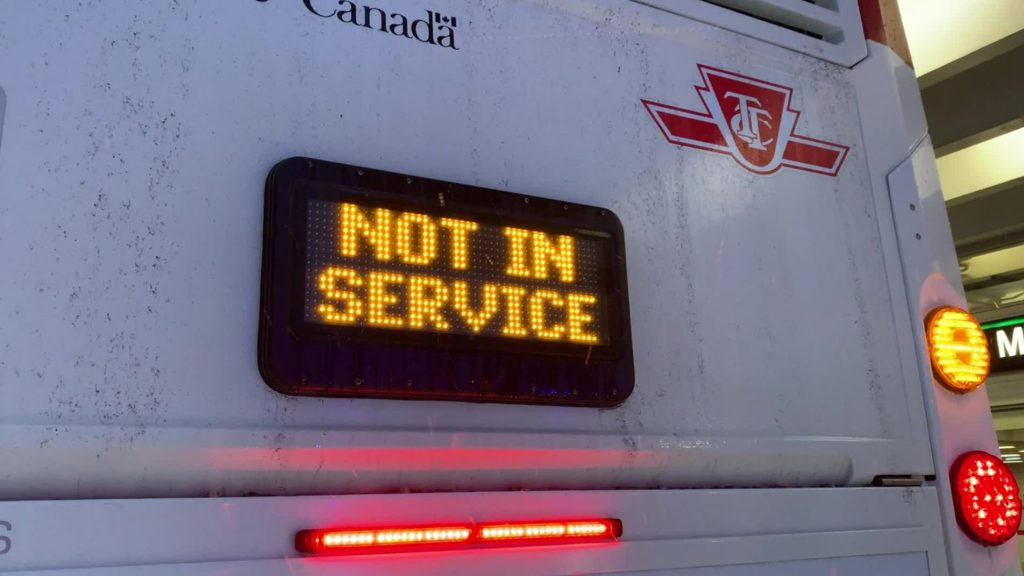Stay-at-home order extended in Toronto and Peel, York Region moving to “Red-Control” zone
Posted February 19, 2021 6:19 am.
Last Updated February 19, 2021 5:56 pm.
Ontario’s government has extended the stay-at-home order in Toronto, Peel Region, and North Bay-Parry Sound for an additional two weeks until at least March 8.
As of Feb. 22 at 12:01 a.m., York Region will subsequently move to the province’s colour-tiered framework and will be placed under “Red-Control”, joining Durham, Halton, Hamilton, and other regions in the process.
Public health regions are required to stay at their level for at least two weeks.
“Our government’s number one priority is the safety of all individuals and families, and that’s why we are taking a gradual, cautious approach to return regions to the Framework,” said Christine Elliott.
“These are difficult but necessary decisions, in order to protect against COVID-19 variants and maintain the progress we have all made together. Until vaccines are widely available, we continue to urge all Ontarians to follow public health advice and measures, and stay home, stay safe, and save lives.”
Ontario’s government said the decision was made in consultation with Chief Medical Officer of Health Dr. David Williams and the local medical officers of health.
Though Peel and Toronto have seen a reduction in daily COVID-19 cases, health officials said rates “still remain too high in the regions”, citing case rates of 83.4 cases per 100,000 people for Peel and 67.9 cases per 100,000 people for Toronto – both well above the provincial average.
Mississauga Mayor Bonnie Crombie approves the decision, saying while the city has made progress, “our Medical Officer of Health is extremely worried about the dramatic increase in the number of variant cases, which we know are much more transmissible.”
She adds “I feel particularly bad for our small business community that had been anticipating opening back up for in-person shopping. My priorities have always been ensuring schools are safe and remain open, protecting our seniors, that our hospitals maintain capacity, and that when small businesses open, they stay open.”
The stay-at-home order was lifted for the majority of the province earlier this week as the government moved ahead with an economic reopening despite warnings it could set off the third wave of infections.
In addition to York Region moving to the province’s colour-coded framework, Lambton Public Health will be shifted from the “Orange-Restrict” level to the “Red-Control” level as a result of “worsening public health trends in the region over the past week,” the government said.
RELATED: Ontario sending inspectors to check on reopening small businesses
After two weeks, the government will assess the impact of public health and workplace safety measures to determine if the region should stay where it is or be moved to a different level.
Public health regions may be moved to a higher level within a two-week window.
“While the health indicators have improved enough to allow us to return an additional region to the Framework, we are not yet at the point where we can safely transition back the remainder of the province,” said Dr. Williams.
“Everyone is strongly advised to continue staying at home, avoid social gatherings, only travel between regions for essential purposes, and limit close contacts to your household or those you live with regardless of which level of the Framework you are in.”
Part of the province’s reopening plan includes an “emergency brake” measure that allows it to swiftly move regions back into lockdown if cases rise.
“Red-Control” measures and details include:
Retail:
- Capacity limits of:
- 75% for supermarkets and other stores that primarily sell groceries, convenience stores, pharmacies
- 50% for all other retail, including discount and big-box retailers, liquor stores, hardware stores, and garden centres
- Stores must post capacity limit publicly
- Stores must have passive screening for patrons (for example, posting signs outside the store front about not entering if you have covid 19 symptoms)
- This does not apply to indoor malls, which are required to actively screen their customers before they enter the mall. Malls can use the patron screening tool to help meet this requirement.
- Stores within the malls subject to appropriate retail measures
Restaurants, Bars, and other food establishments:
- Capacity limits, where physical distancing can be maintained:
- 10 patrons seated indoors
- Outdoor dining, take out, drive through, and delivery permitted, including alcohol
- No buffet style service
- Line-ups and patrons congregating outside venues managed by venue; 2 metres distance and face-covering required
- Screening of patrons is required, in accordance with instructions issued by the Office of the Chief Medical Officer of Health
- Require patrons to be seated; 2 metres minimum or impermeable barrier required between tables
- Limit of 4 people may be seated together
- Require contact information for all seated patrons
- Face coverings required except when eating or drinking only
- Personal protective equipment, including eye protection, required when is a worker must come within 2 metres of another person who is not wearing a face covering
- Establishments must be closed from 10 p.m. to 5 a.m.
- Liquor sold or served only between 9 a.m. to 9 p.m.
- No consumption of liquor permitted between 10 p.m. to 9 a.m.
- Dancing, singing and the live performance of music is prohibited
- Limit volume of music to be low enough that a normal conversation is possible
- Night clubs and strip clubs only permitted to operate as restaurant or bar
- A safety plan is required to be prepared and made available upon request
Public Events and Social Gatherings:
- Limits for all organized public events and social gatherings:
- 5 people indoors
- 25 people outdoors
- Limits for religious services rites or ceremonies, including wedding services and funeral services, where physical distancing can be maintained (applies in any venue other than a private dwelling):
- 30% capacity of the room indoors
- 100 people outdoors
Sports and Fitness Facilities:
- Maintain 2 metres physical distancing at all times
- Increase spacing between patrons to 3 metres in areas where there are weights or exercise equipment and in exercise and fitness classes
- Capacity limits, where physical distancing can be maintained
- 10 people in indoor areas with weights and exercise machines
- 10 people in all indoor classes or
- 25 people in outdoor classes
- No spectators permitted, however, each person under 18 may be accompanied by one parent or guardian
- Team sports must not be practiced or played except for training (no games or scrimmage)
- Activities that are likely to result in individuals coming within 2 metres of each other are not permitted; no contact permitted for a team or individual sports
- Exemptions for high-performance athletes and parasport
- Patrons may only be in the facility for 90 minutes except if engaging in a sport
- Limit volume of music to be low enough that a normal conversation is possible; measures to prevent shouting by both instructors and members of the public
- Face coverings required except when exercising
- Require contact information for all members of the public that enter the facility
- Require reservation for entry; one reservation for teams
- Screening of patrons is required, in accordance with instructions issued by the Office of the Chief Medical Officer of Health
- A safety plan is required to be prepared and made available upon request
The plan was to move Toronto, Peel, and York back into the colour-coded pandemic framework on Feb. 22 as part of the province’s gradual reopening.
But health officials in Toronto and Peel asked for the reopening to be delayed another two weeks, and then reassess the situation on March 9.
RELATED – Relaxing restrictions: Why Peel Region might not be ready to ease public health measures
Toronto’s top doctor Eileen de Villa announced earlier this week that she had written to provincial health officials and asked that the city’s lockdown and stay-at-home measures be extended.
“The variants of concern mean we face a deceptively dangerous situation,” said de Villa. “Right now, the case count numbers don’t look so bad. They don’t sound bad. But today’s variant count is the tip of an iceberg.”
I've never been more concerned about the threat of #COVID19 in TO. I'd love to say we're ready to reopen, but today it's better to delay until the time is right. Let's keep doing all we can to protect our city so we can get back to brighter days sooner: https://t.co/hLb9AhwiIp
— Dr. Eileen de Villa (@epdevilla) February 17, 2021
John Tory confirmed on Thursday that he stands behind de Villa and believes the current restrictions should remain in place.
“I think most people, given the choice of locking down again in a month or taking a little more time now to do this carefully with great caution, they would take the caution,” said Tory.
According to numbers from Toronto Public Health, as of Feb. 17, there are a total of 57 confirmed variant cases in the city. That makes an increase of over 20 cases in the last week.
Peel’s chief medical officer of health, Dr. Lawrence Loh, has said he supports the reopening of schools but any further economic reopening is risky a move.
Loh says if the province does move Peel back into the framework, it must bolster protections for workers.
Prior to Friday’s announcement, Dr. Karim Kurji, York Region’s medical officer of health, asked that his region be placed into “Red-Control” as part of the provincial framework.
The latest provincial numbers confirm 348 cases of the B.1.1.7 variant first detected in the UK and ten cases of the B 1.351 variant first detected in South Africa. That makes 10 additional B.1.1.7 variant cases and four B 1.351 variants compared to a day ago.
The latest provincial modelling data released last week suggested that the B.1.1.7 variant will soon become the dominant strain of the virus in the province.








